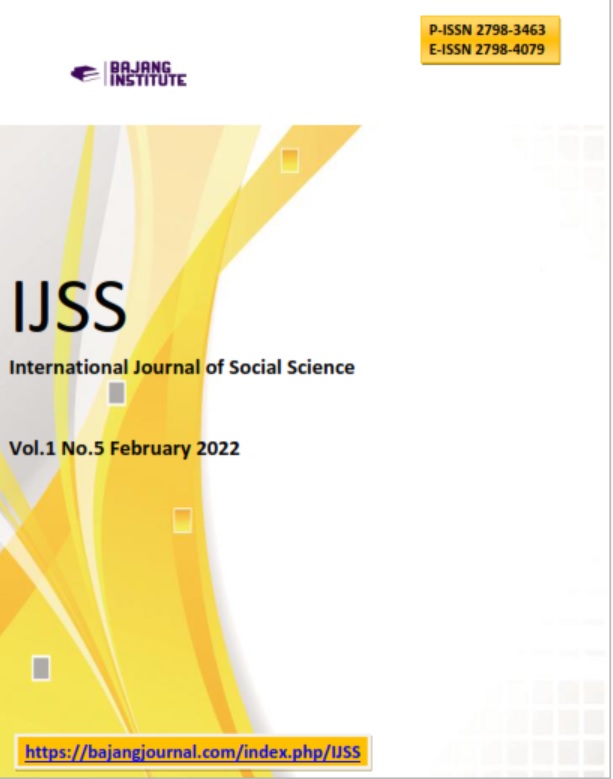THE APPLICATION OF THE FIRST LANGUAGE ACQUISITION MODEL OF 'LINGUISTIC BEHAVIOR'
DOI:
https://doi.org/10.53625/ijss.v1i5.1301Keywords:
Language Acquisition, Language Learning, Linguistic BehaviorAbstract
This study aims to describe the process of children's language development and to find out the application of the language acquisition model of 'linguistic behavior' in foreign language learning.The design of this study was a quasi-experimental time series design. The populations in this study were all first graders at theSamarindaUlu International Elementary School, Samarinda City. The sample is the part of the population that is considered as the representative of the population. The sampling technique used is purposive sampling. The sample inclusion criteria were 15 first grade students at SamarindaUluInternational Elementary School who were selected based on their foreign language knowledge abilities. Data were taken from respondents based on three times of habituation by applying the linguistic behavior model.The results of the study showed that the process of children's language acquisition in language learning consists of two processes, namely the understanding process and the mastery process. The process of understanding is obtained naturally by every child through the experiences he/she has gone through. Furthermore, the process of mastering language is acquired after the child is able to apply the language that is understood based on the actual function and the meaning of the language. The application of the linguistic behavior language acquisition model conducted through several stages of habituation (1, 2 and 3) which can help to improve language development at 1st graders at SamarindaUlu International Elementary School, Samarinda, especially in learning English. By doing the habituation, children are helped to understand and master the foreign language they are learning, such as when they acquire the first language through habituation or experience that they are not even aware of.
References
Budiman, (2011), Penelitian Kesehatan, Bandung, Refika Aditama
Brown, Douglas, H. (1980). Principles of Language Learning and Teaching. New Jersey: Prentice Hall Inc,
Chaer, Abdul. (2003). Psikolinguistik:KajianTeoretik.Jakarta: PT RinekaCipta.
Chaer, Abdul danLeoniagustina. (2003). Sosiolinguistik:PerkenalanAwal.. Jakarta: RinekaCipta, 1995, dalamChaer.
Chomsky, Noam. (1999).On Nature, Use, and Acquisition of Language.”Dalam Ritchie dan Bhatia.
Dardjowidjojo, Soenjono. (2003). Psikolinguistik:Pengantar Pemahaman Bahasa Manusia. Jakarta: YayasanObor Indonesia.
Dharma, Kusuma Kelana. (2011). Metodologi Penelitian Keperawatan: Panduan Melaksanakan dan Menerapkan Hasil Penelitian, Jakarta, Trans InfoMedia.
Ellis, Rod. (1986). Understanding Second Language Acquisition, New York: Oxford University Press.
Field, John. (2003). Psycholinguistics. London: Routledge.
Krashen, Stephen D. (1972). “Laterization, Language, Learning and the Critical Period: Some New Evidence.” Language Learning.
Kridalaksana, Harimurti. (1982). KamusLinguistik.Jakarta: PT Gramedia.
The McGill ConfereceInHonour of Wallace E. Lambert. (1991). Bilingualism, Multiculturalism, and Second Language Learning, Hillsdale, New Jersey: Lawrence Elbraum Associates, Inc, Publisher, 1991
Marat, Samsunuwiyati. (1983). Psikolinguistik. Bandung: Fakultas Psikologi Universitas Padjadjaran.
Martinet, Andre. (1987). Ilmu Bahasa: Pengantar (terjemahan Rahayu Hidayat). Yogyakarta: Kanisius.
Musfiroh, Tadkirotun. (2002). Pengantar psikolinguistik. Yogyakarta: Fakultas Bahasa dan Seni, Universitas Negeri Yogyakarta.
Natsir, Nurasia. (2017), Hubungan Psikolinguistik dalam Pemerolehan dan Pembelajaran Bahasa, Vol. 10 No. 1 Februari 2017 Jurnal Retorika
Nikelas, Syahwin. (1988). Pengantar Linguistik untuk Guru Bahasa. Jakarta Depdikbud: DepdikbudDirjenDikti PPLPTK.
Pateda, Mansoer. (1990). Aspek-aspekPsikolinguistik.Ende Flores: Nusa Indah
Riyanto, Agus. (2011). Aplikasi Metodologi Penelitian Kesehatan. Yogyakarta: Nuha Medika.
Sugiyono, (2011).Metodologipenelitian. Bandung: Alfabeta.
Tarigan, Henry Guntur. (1985). Psikolinguistik.Bandung: Angkasa.
Yudibrata, Karna; AndoyoSastromiharjo; danKholid A. Harras.(1997/1998).Psikolinguistik.Jakarta: Depdikbud PPGLTP Setara D-III.

















